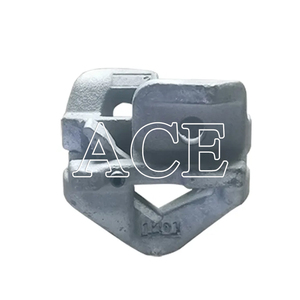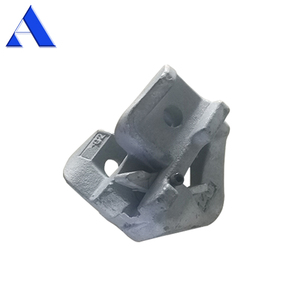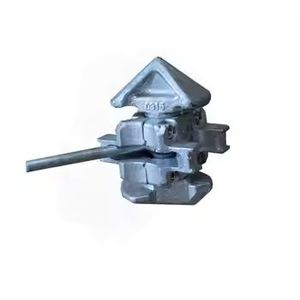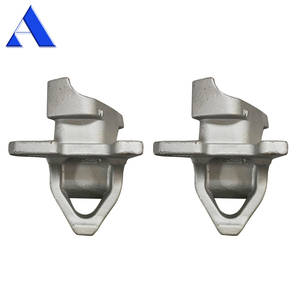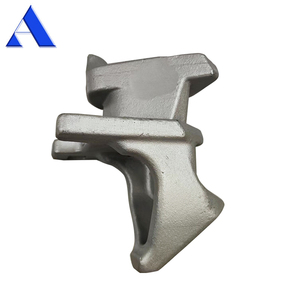Types of Container Lashing Twistlock
Container lashing twistlocks are essential components used in securing containers on ships and during transportation to ensure safety and stability. They come in various types, each designed to meet specific needs and applications.
Expert Tip: Choosing the right type of twistlock is crucial for ensuring cargo security. Consider factors like vessel type, cargo weight, and sea conditions when selecting the appropriate lashing system.
Used for single lashing operations, connecting a single lashing line to the container corner. These are the most common type found on container vessels and provide reliable security for standard shipping conditions.
These specialized twistlocks attach two lashing lines to a container, providing extra security and stability. Particularly valuable in rough weather or high seas where additional reinforcement is required.
Feature self-securing and releasing mechanisms that significantly reduce loading/unloading time. These advanced twistlocks minimize labor requirements while enhancing security by reducing the risk of accidental release.
Require hands-on operation for locking and unlocking. Though more labor-intensive than automatic versions, they're widely valued for their exceptional reliability, strength, and lower cost of implementation.
Specifically engineered for refrigerated containers, these twistlocks maintain secure connections while accommodating the special requirements of temperature-controlled shipping environments.
Designed to fit into designated sockets on ship decks or container chassis, providing secure connection points for lashing lines and enhancing overall stability during transit.
| Twistlock Type | Primary Application | Key Benefits | Considerations |
|---|---|---|---|
| Base Twistlocks | Container stacking | Stabilizes stacks, prevents toppling | Must be rated for appropriate weight capacity |
| Corner Castings with Twistlocks | Corner security | Integrated design, enhanced connection | More expensive than standard options |
| Intermodal Twistlocks | Multi-transport security | Versatile across transport modes | Must comply with various transport regulations |
Specifications and Maintenance of Container Lashing Twistlock
Key Specifications
Understanding the technical specifications of container lashing twistlocks is essential for selecting the right equipment for your specific shipping needs.
Critical factor: Always verify load capacity meets or exceeds your container weight
Maintenance Requirements
Proper maintenance ensures the longevity and reliability of twistlocks, preventing costly failures and safety hazards during transportation.
Maintenance schedule: Regular inspection and cleaning after each voyage
Technical Specifications
Typically manufactured from high-grade steel materials: stainless steel for corrosion resistance in marine environments, or carbon steel for applications requiring maximum strength and durability.
Available in various standardized dimensions to accommodate different container types. Size directly affects strength and load capacity, with larger twistlocks generally handling heavier loads.
Ranges from 20 to 50 tons depending on design and materials. This specification indicates the maximum weight the twistlock can secure safely without structural failure.
Premium twistlocks feature specialized coatings or materials that withstand harsh marine environments, preventing degradation from saltwater exposure and extending operational lifespan.
Advanced models include tamper-evident mechanisms, locking indicators, and specialized locking systems to prevent unauthorized access or accidental disengagement.
Different designs accommodate specific vessel types, stacking arrangements, or transportation scenarios, ensuring optimal security across various shipping contexts.
Safety Warning: Never use twistlocks with visible damage, deformation, or excessive corrosion. Even minor structural issues can lead to catastrophic failures when under load.
Maintenance Best Practices
| Maintenance Task | Frequency | Procedure | Importance |
|---|---|---|---|
| Visual Inspection | Before and after each use | Check for cracks, wear, deformation, and damage | Critical |
| Cleaning | After each voyage | Remove dirt, salt deposits using mild detergents | High |
| Lubrication | Monthly or as needed | Apply manufacturer-recommended lubricants to moving parts | High |
| Load Testing | Annually | Verify operation under controlled load conditions | Critical |
| Storage | When not in use | Keep in dry area away from corrosive substances | Medium |
| Personnel Training | Initially and annually | Instruct on proper handling, inspection and maintenance | High |
Maintenance Tip: Create a documented maintenance log for each set of twistlocks to track inspection history, repairs, and replacement dates. This documentation is invaluable for safety compliance and can help identify patterns of wear or failure.
How to Choose Container Lashing Twistlock
Selecting the right twistlock for container lashing requires careful consideration of several critical factors to ensure safety, compatibility, and operational efficiency.
Determine the appropriate twistlock type based on your specific application. Standard twistlocks work for general purposes, while hydraulic options are better suited for heavy-lift operations requiring precision control.
Prioritize high-quality construction using marine-grade materials like stainless or forged steel. Premium materials offer superior durability and corrosion resistance in harsh maritime environments.
Select twistlocks with load capacity ratings that exceed your maximum container weight by at least 20%. This safety margin accounts for dynamic forces during transport and unexpected load shifts.
Verify that your chosen twistlocks meet all relevant industry standards, including ISO requirements and classification society approvals. Compliant equipment ensures regulatory acceptance and insurance validity.
Look for safety enhancements like visual locking indicators, fail-safe mechanisms, and anti-rotation designs that prevent accidental disengagement during transport.
Consider operational efficiency by selecting twistlocks that are ergonomically designed for quick installation and removal, reducing handling time and labor costs.
Cost vs. Quality Considerations
While budget constraints are important, investing in quality twistlocks ultimately provides better value through extended service life and reduced replacement frequency.
Value metric: Calculate cost per voyage rather than upfront price
Brand Reputation
Established manufacturers with proven track records typically offer superior products with consistent quality control and reliable after-sales support.
Research tip: Consult industry forums and shipping professionals for recommendations
Selection Advice: When evaluating twistlocks for purchase, request sample units for hands-on assessment. Testing the actual operation, examining build quality, and verifying dimensions in person can reveal issues that aren't apparent in product specifications.
| Selection Factor | Priority Level | Evaluation Method |
|---|---|---|
| Load Capacity | Critical | Verify certification documents and test reports |
| Material Quality | High | Check material composition and corrosion protection |
| Compliance | Critical | Confirm ISO certification and regulatory approvals |
| Operational Efficiency | Medium | Test installation/removal time and ergonomics |
| Safety Features | High | Evaluate fail-safe mechanisms and indicators |
| Cost Effectiveness | Medium | Calculate total cost of ownership over service life |
| Manufacturer Support | Medium | Research warranty terms and parts availability |
How to DIY and Replace Container Lashing Twistlock
Proper replacement of container lashing twistlocks is essential for maintaining cargo security. Following these step-by-step instructions ensures a safe, effective installation process.
Safety First: Always wear appropriate personal protective equipment including gloves, safety glasses, and steel-toed boots when working with twistlocks. Ensure the work area is stable and secure before beginning the replacement process.
Begin with a thorough examination of the existing twistlock, noting any damage, wear patterns, or corrosion. Document these observations to help identify potential installation issues. Simultaneously inspect surrounding equipment and securing systems to ensure overall functionality.
Choose a replacement that precisely matches the original specifications, paying special attention to dimensions, load rating, and operational mechanism. Using mismatched components can compromise the entire securing system and create dangerous conditions.
Gather all necessary tools including appropriate wrenches, torque tools, and any specialized equipment recommended by the manufacturer. Clear the workspace of obstructions and ensure adequate lighting for precision work.
Carefully disconnect and remove fasteners according to the manufacturer's recommended sequence. Store removed hardware in a designated container to prevent loss. Extract the old twistlock with controlled movements to avoid damaging surrounding components.
Position the new twistlock with precise alignment to mounting points. Secure using appropriate fasteners, following the manufacturer's torque specifications. Improper torque can lead to premature loosening or component damage.
Perform operational testing by cycling the twistlock through its full range of motion multiple times. Verify proper engagement with containers or securing points. Check for smooth operation without binding, excessive resistance, or unusual noises.
Conduct a comprehensive post-installation inspection, checking all connection points for security. Verify proper alignment with mating components and confirm that all safety features function as designed.
Properly dispose of replaced twistlocks according to environmental regulations. Many components contain recyclable materials that should be processed appropriately rather than discarded as general waste.
Installation Tip: Always apply an appropriate marine-grade anti-seizing compound to threaded fasteners before installation. This prevents corrosion-based seizure and makes future maintenance or replacement significantly easier, especially in saltwater environments.
Questions and Answers
While not universally required by law for all vessels, twistlocks are strongly recommended and considered industry standard practice for securing containers during maritime transport. Most shipping insurance policies and classification societies require proper container securing systems, including twistlocks, to maintain coverage and certification. The use of twistlocks significantly reduces the risk of cargo loss, which is critical for protecting both the shipowner's liability and the cargo owner's investment.
No, twistlocks are not universally interchangeable across all container types and securing systems. Different sizes and designs of twistlocks are engineered for specific applications, container dimensions, and weight capacities. Using incorrectly sized or specified twistlocks can compromise cargo security and potentially lead to catastrophic failures during transit. Always consult manufacturer specifications and industry standards to ensure proper matching between twistlocks and their intended container applications.
Maintaining twistlocks in optimal condition requires a systematic approach to inspection and maintenance:
- Conduct visual inspections before and after each use, looking for cracks, deformation, excessive wear, or corrosion
- Regularly clean twistlocks to remove salt deposits, dirt, and debris that can accelerate corrosion
- Apply appropriate marine-grade lubricants to moving parts according to manufacturer recommendations
- Test operation regularly to ensure smooth functioning of locking mechanisms
- Replace twistlocks that show any signs of structural compromise, regardless of age
- Maintain detailed records of inspection dates, findings, and maintenance performed
- Follow manufacturer guidelines for maximum service life and replacement intervals
The operational lifespan of container lashing twistlocks varies significantly based on several factors including material quality, frequency of use, exposure to environmental conditions, and maintenance practices. In general, high-quality twistlocks used in standard shipping operations with proper maintenance can last between 3-5 years. However, twistlocks used in harsh environments or subject to heavy-duty applications may require replacement more frequently. Always follow manufacturer recommendations for service life and implement a regular inspection protocol to identify when replacement becomes necessary.
While technically possible in some configurations, mixing automatic and manual twistlocks within the same securing system is generally not recommended. The different operational characteristics and handling requirements can lead to confusion among crews, potentially resulting in improper securing procedures. Additionally, the varying operational speeds and mechanisms might create uneven load distribution during dynamic conditions. For optimal safety and efficiency, it's best to maintain consistency in twistlock types within a given securing system and ensure all crew members are properly trained on the specific equipment in use.



























